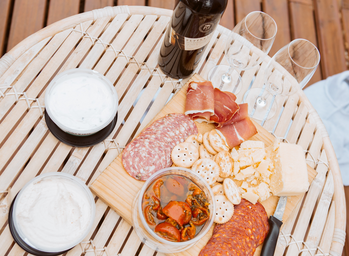Ah, the aperitivo. The hallmark of an Italian getaway. The masterpiece of colorful bites and blood-red drinks. The heavenly first sip after a long day at the office, marking the end of work and the beginning of play. Clink, sip, ah. In the home of Da Vinci’s Last Supper, luxury fashion brands, and all things “Made in Italy,” the aperitivo is an art in itself, perhaps more so than any other fixture of Italian life.
The roots of the aperitivo can be summed up in one word: experimentation. But Italian bartenders are more than scientists – they are artists, designers, and inventors who have been crafting their perfect infusions for centuries. Born in Turin and raised in Milan, the aperitivo – whose name indicates the “opening” of one’s appetite – is often compared to the American “happy hour,” everyone’s favorite time of day when bars and restaurants serve drinks and small bites at reduced prices. But the two are actually quite different. Here’s why.
- Aperitivo is typically longer, and happens everyday
Why limit happy to an hour? Happy hour in the U.S. started in 1914 when sailors in the Navy engaged in entertainment for a short time to escape hardship on the ships. The tradition quickly centered around alcohol when speakeasies offered drinks after work in the 1920s. It’s five o’clock somewhere. While fading away, plenty of establishments still stick to the one-hour tradition for business reasons, with certain chains expanding to two hours. Meanwhile, in Italy, the aperitivo can last for up to three hours. With dinner usually eaten later than in America, aperitivo naturally starts an hour or so later than its Western cousin. There are no hard and fast rules, but aperitivo can begin as early as 6 p.m. and end as late as 9 p.m., when trattorias and other eateries open their doors for dinner.
Even better, the ritual aperitivo is observed seven days a week, while happy hour is typically limited to Monday through Friday, with some bars keeping customers happy by offering weekend specials. In Italy, it truly becomes a daily ritual. Get up, get ready, go to work, get off work, aperitivo. And who can complain? What better way to kick off the night than by clinking a glass of Aperol Spritz with your friends?
- No discounts, but unlimited food
Why is happy hour so happy? Well, the prices speak for themselves. With $5 beers and cocktails under $10, it’s no wonder why this hour is so magical. No such discounts exist in Italy, but here’s the catch: your drink is often accompanied by a free buffet, with customers free to choose from an array of starter-style foods. Some staples include salumi, prosciutto, cheese, fresh fruit, vegetables, and olives, often served aesthetically on a cutting board.
As aperitivo lights up venues from casual street bars to elegant terraces, the code varies from place to place. However, the basic formula is as follows: Upon entering (and after booking a reservation for popular spots), the waiter will bring you to your table. Prego. You pay for one drink – Vorrei un Spritz – then, you’re free to enjoy a limitless selection of savory bites. Take your food, eat, enjoy, and repeat (if you’d like). Then, it’s time to head home for dinner, or stay out, if you want. Ci vediamo. Doesn’t get much better than that.
- Aperitivo is a palate primer, while happy hour can take place of dinner
That means traditional aperitivo drinks are lighter than their heavier counterparts that might be enjoyed in nightclubs. True aperitivo drinks are more bitter than sweet. You can never go wrong with a classic Spritz, a light, refreshing concoction of prosecco, bitter liqueur, and soda, often garnished with an orange slice. The Spritz is the undisputed king of aperitivo, to which all other drinks will bow, including the classic Negroni, Americano, and any local wine. No alcohol? No problem! Those looking to cut the booze can discover equally flavorful virgin alternatives at thousands of bars across Italy.
Alcohol or not, the idea here is not to fill yourself up to the point of intoxication, but to enjoy a nice refreshment while catching up with friends. The same goes with any food that might come with an aperitivo drink. Certain cities like Milan widely offer buffet-style service. But don’t expect to stack on plate after plate. To Italians, a buffet is not an invitation to scarf down your meal. The snacks are simply a way to complement your drink as you socialize. Not in the mood for salumi? Try an arancini, a ball of risotto and an Italian classic; tramezzini, small triangular sandwiches; or even mini pizzas. The possibilities are truly endless when it comes to Spritz pairings.
At its core, the Italian aperitivo is about friendship, conversation, and connection, with drinks and light snacks meant to amplify all three. It’s more talk, sip, talk, than untz, untz, chug, yell over the music. Everything in moderation. Sit down, grab a drink or two, snack on some prosciutto and savory cheese, and most importantly, enjoy yourself and your company. Respect these rules, and you’ll find yourself tied to the Italian tradition for life.


